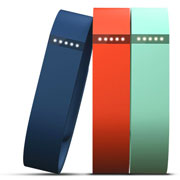
Fitbit users who frequently forget or misplace their fitness trackers now have a new option: Fitbit Flex, a version of the popular Fitbit device that’s designed to be worn on the wrist, became available on Monday.

Fitbit Flex, which retails for US$99.95, is a bit larger than the typical silicone awareness bracelet and features a pedometer, sleep tracker, vibrating alarm and calorie tracker. Compatible with both Android and iOS, it can sync with compatible apps via Bluetooth 4.0.
Whereas previous Fitbit devices were designed to be clipped to the user’s clothing, the Fitbit Flex joins a growing crowd of wristband-style exercise products, including the Nike+ FuelBand and Jawbone Up.
Can Be Worn in the Shower
The Fitbit Flex comes with a choice of black or gray waterproof bands, but replacement bands in two sizes and numerous colors are also available. The device can be worn both day and night, even while in the shower.
Inside the band resides Fitbit’s smallest tracker to date, capable of monitoring steps, distances, calories burned, and active minutes. LED lights show progress against the wearer’s goal. Both a charging cable and a wireless sync dongle are included.
The Flex’s battery is rated to last five to seven days.
At least as important as the Fitbit Flex’s functionality is its fashionable appearance, Julie Sylvester, coproducer of Living in Digital Times, told TechNewsWorld.
“The wearable tech market is only going to get bigger in the coming months,” Sylvester explained. “People will want a dedicated fitness device if for no other reason than the fashion statement.”
No Screen Time
While the Fitbit Flex does offer much of the functionality of a dedicated fitness monitor, it does so only when paired with a compatible device. There’s no screen for real-time monitoring.
At present, the Flex offers direct syncing only with the iPhone, Samsung GS3 and Galaxy Note handsets.
“The Fitbit Flex is a smartphone peripheral,” telecommunications analyst Stephen Blum of Tellus Venture Associates told TechNewsWorld.
“If you’re tracking moving and sleep patterns, sensors inside of a phone would not be optimal. You might sleep with your phone next to you, but you won’t have it on you,” Blum explained.
“Day to day, you might not carry it in a way that optimizes movement tracking, or have it with you at the gym, and certainly not in the pool,” he noted. “It’s an example of why wearable computing has a future as peripheral sensing, display and control devices.”
The Smartwatch Factor
Of course, few devices do everything, and the Fitbit Flex is no exception.
“It doesn’t monitor heart rate, which is a shame, but you really need something with a display you can see for that anyway,” Rob Enderle, principal analyst at the Enderle Group, told TechNewsWorld.
Now that smartwatches are on the horizon, are devices such as the Flex too limited?
“This will likely be a category for those that don’t want a smartwatch,” Enderle predicted. “This is the most obvious capability for this class of smart devices, and they will be able to add things like heart rate monitors.”
In fact, “a lot of folks will likely resist having a heavy smartwatch on their wrist, and will prefer an accessory that will connect to their smartphone as a hub instead.”
Since smartwatches haven’t even truly launched yet, this class of product will have “time to mature and defend their turf,” he added.
‘2 or 3 Years of Leeway’
In the long run, however, it’s likely that fitness monitors and smartwatches will overlap, Blum predicted.
“A lot of this technology will converge into a single smartwatch,” he explained. “The easy part is shrinking sensor hardware and energy consumption — that’s a continuous process that you can count on.”
The harder part will be “integrating software, both on board the watch and in smartphones, in a way that properly addresses the fitness market,” Blum said. “Special purpose wearable peripherals, like the Fitbit Flex, have at least two or three years of leeway in the market before smartwatches will truly threaten them.”
Further down the road, “this likely will be a capability added to a future smart device, but the perfect device is likely at least five years out,” said Enderle. “Even then, people may prefer a remote sensor to one installed in it.
“The eventual path,” he added, “is likely a group of sensors surgically installed and powered by you.”





















































